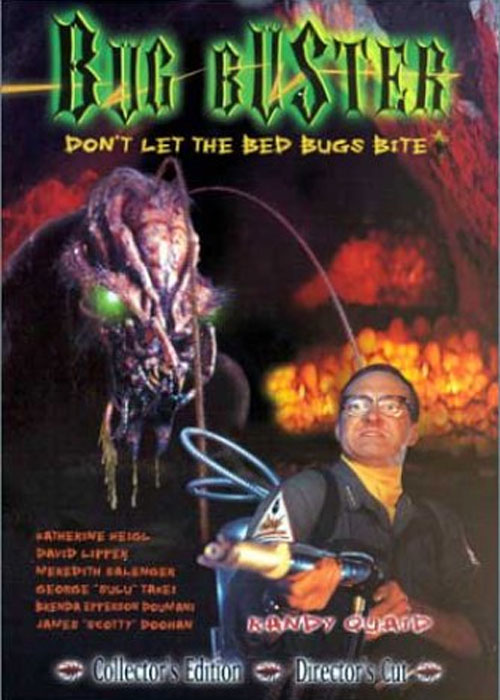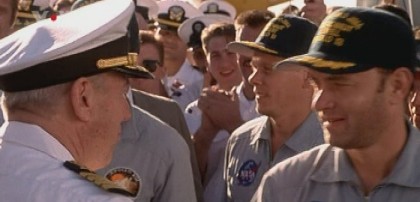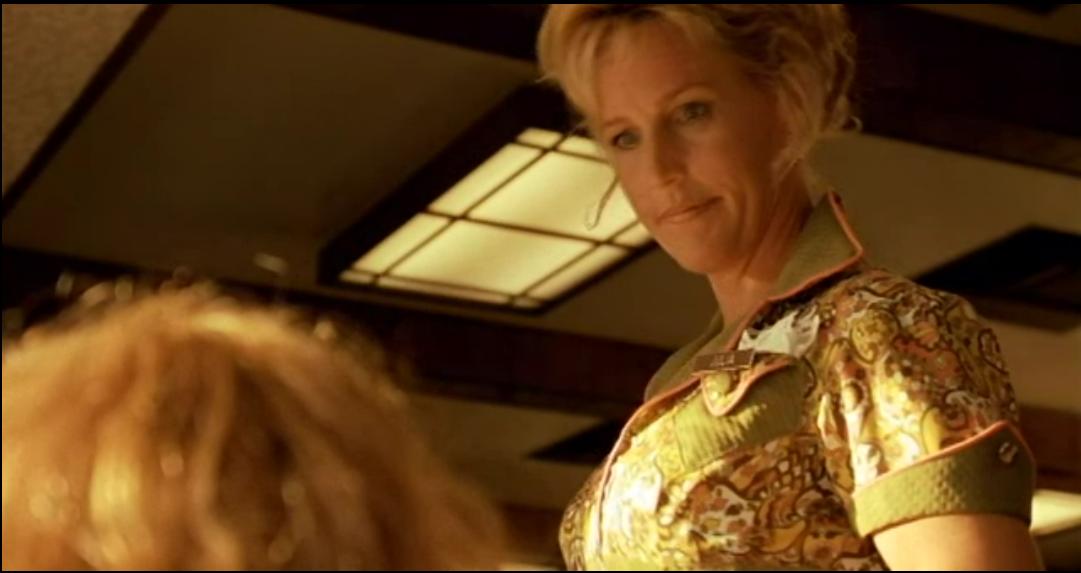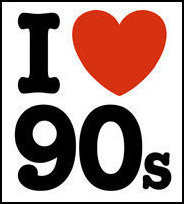
Sometimes we forget that it takes years of careful publicist-managed grooming to create a respectable public persona for an actor. Strange as it may seem now, many celebrities who we respect and admire for their legitimate talent were once groveling for B-movie parts. Hey, everyone's got to start somewhere. The bottom seems like as good a first step as any.
Admittedly, not all of the actors on this list are Oscar contenders, but no matter their current position on the fame totem pole, they've certainly come a long way since these early parts. The sheer number of actors who got their start slumming in campy horror flicks are too many to list in a single post, so I present to you a small entertaining slice of now-famous actors' early horror roles. Extra credit has been awarded for worst titles, least necessary sequels, best punny tagline, and cheesiest poster art*.
Jennifer Aniston: Leprechaun

It's a tale as old as time: someone steals an ornery leprechaun's gold coins, they lock him up, the new homeowners release him, and he wreaks havoc by going on a homicidal spree. Same old story. Well, it should be, at least, considering they made 5 follow-up sequels. The most recent (2003) is Leprechaun: Back 2 tha Hood. I can't believe I missed it.
Jennifer Aniston plays the new homeowner terrorized by the deviant little green guy. Lucky for her, she got her big break with Friends later that year. Without the Rachel role, who knows? She could have been starring in Leprechaun: Back 3 tha Hood.
Leonardo DiCaprio: Critters 3
 In case you missed the first two installments, let me fill you in. There are these critters, see. And...that's it. The whole thing. A franchise is born.
In case you missed the first two installments, let me fill you in. There are these critters, see. And...that's it. The whole thing. A franchise is born.Critters 3 is the first clip in this montage. DiCaprio's adorable. Almost as cute as the critters.
This is DiCaprio's first film, a breakthrough role in which he deftly maneuvers the role of the evil landlord's stepson. Spooky, right? This stepdad landlord is so evil that he gets comeuppance in the manner of being locked by DiCaprio in the basement with the critters. And you thought your family was dysfunctional.
Eva Mendes: Children of the Corn V: Field of Terror

I'll bet you never realized this film warranted so many sequels, but apparently these Children of the Corn have a lot of stories to tell. Eva Mendes had a major-ish role in this installment, playing a teenager who surrenders to the cult. She can't quite measure up to Alexis Arquette in the lead male role, but she has her moments.
Mariska Hargitay: Ghoulies

Really? Ghoulies? That' a movie? You know it's a top shelf kind of film when the cover has a low-budget monster popping out of a toilet. And the tagline "They'll get you in the end." Get it? Unfortunately. Really, that was the best they could do.
This. Is. Hilarious. If you're a Hargitay fan, I implore you to watch this. You won't be sorry.
Mariska Hargitay may have won us over as tough-on-sex-crimes officer Olivia Benson on Law and Order SVU, but back in 1985 she was accepting roles like "Donna in Ghoulies." You'd think having Jayne Mansfield for a mom would give you an in. You would be wrong.
Jim Carrey: Once Bitten

Aren't vampires hilarious? That was the central thesis of this 1985 vampire horror comedy starring Jim Carrey in his first major role. The plot is almost too ridiculous to warrant an in-depth study, but suffice it to say it was pretty terrible. At least it was a comedy: that's it's primary redeeming feature.
George Clooney: Return of the Killer Tomatoes and Return to Horror High


Clooney's lucky that he's got his good looks to fall back on: not all actors can achieve such monumental fame after starring in such humiliating horror sequels. I don't want to confuse you with too many clever plot details, so suffice it to say both movies involved an unnecessary revisiting of the first films' respectively ridiculous storylines. Things return.
Brad Pitt: Cutting Class

Get it? Cutting? These movie people are just too punny for words. This was Pitt's first major screen role, with his role as hunky high school basketball Dwight Ingalls establishing him as an up-and-comin hearthrob. Dwight Ingalls in possibly the most prototypical late 80s/early 90s movie character name: cheesy yet unlikely. I wonder if they have a mechanism where you can insert a normal-sounding name and then a corny 80s name like "Dash Harrington" or "Kassandra Kellogg" pops out.
Hilary Swank: Sometimes They Come Back Again

How's that for a sequel title? Sometimes They Come Back... Again. Someone on the writing team could use a refresher course on redundancy. Didn't they already come back? Is it really necessary to add that "again?" Especially when you've already got the "sometimes" in there to imply it happens periodically. It just highlights the fact that this movie is totally unnecessary. Well done.
Whatever my qualms with the title, it does have one redeeming quality: a future Oscar winner. Hilary Swank plays the main character's teenage daughter. I'd offer some more useful details, but to be honest I couldn't even make it through the synopsis. It's just that bad.
Katherine Heigl: Bug Buster and Bride of Chucky
 I was going to put the Bug Buster trailer right...here but it was so disgusting I thought it better to spare you. YouTube it at your own risk. If you are terrified of bugs like me, it may be traumatizing. Don't say I didn't warn you.
I was going to put the Bug Buster trailer right...here but it was so disgusting I thought it better to spare you. YouTube it at your own risk. If you are terrified of bugs like me, it may be traumatizing. Don't say I didn't warn you. Another two-for-one deal here for former B-movie stardom. Heigl may have caught our attention with her young role in 1994's My Fatehr the Hero opposite Gerard Depardieu, but it was a good 10 years before she caught her big break with Grey's Anatomy**. During this time she did a few stints on the horror circuit, most memorably as sassy teenager Jade Bride of Chucky, the fourth film in the Child's Play series. By this time they weren't even trying anymore; the series was teetering on the edge of self-referential parody.
Another two-for-one deal here for former B-movie stardom. Heigl may have caught our attention with her young role in 1994's My Fatehr the Hero opposite Gerard Depardieu, but it was a good 10 years before she caught her big break with Grey's Anatomy**. During this time she did a few stints on the horror circuit, most memorably as sassy teenager Jade Bride of Chucky, the fourth film in the Child's Play series. By this time they weren't even trying anymore; the series was teetering on the edge of self-referential parody.That same year (1998) Heigl also appeared in Bug Buster, a film about massive mutant underwater cockroaches. Take a second, it's exactly as stupid as it sounds. To the film's credit, Scotty and Sulu from Star Trek are in it. Other than that, it's pretty much a bust...er. Bug Buster. Right.
Somewhere along the way these stars caught their lucky break, but not before paying their dues with some pretty embarrassing horror flick gigs. It may not be their best work, but it'll be a part of their acting canon for life. Or at least they will stick around to forever haunt them in their readily fan-accessible IMDB pages. Spooky.
*The term "art" here has been used loosely
**To be fair, I also liked her on Roswell






















